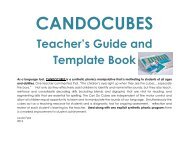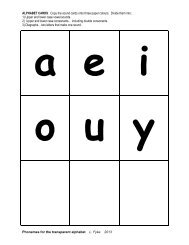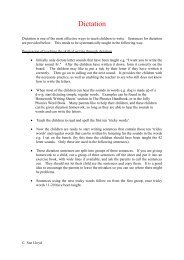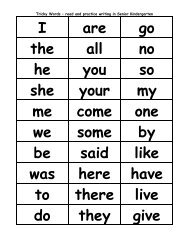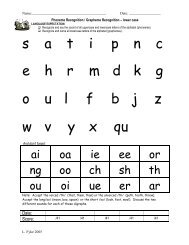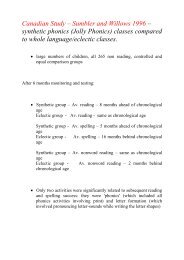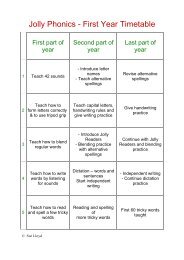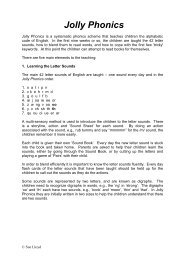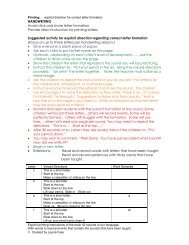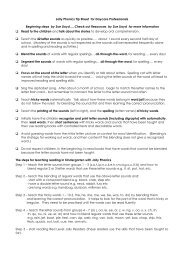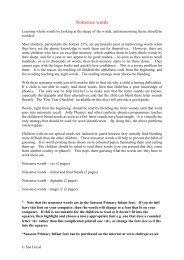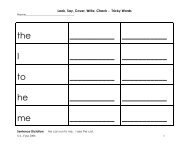Developmental Tasks.pdf - Primarily Learning
Developmental Tasks.pdf - Primarily Learning
Developmental Tasks.pdf - Primarily Learning
You also want an ePaper? Increase the reach of your titles
YUMPU automatically turns print PDFs into web optimized ePapers that Google loves.
Language<br />
Development<br />
Listening<br />
Development<br />
Visual<br />
Development<br />
Fine Motor/<br />
Eye Hand<br />
<strong>Developmental</strong> Reading <strong>Tasks</strong> Toddler to 3 +<br />
NOTE:<br />
Remember to provide numerous and varied learning opportunities through<br />
games, music and activities for young children. Some of the activities listed may<br />
be presented when the child is a toddler. Children develop at varying rates.<br />
Some children will quickly grasp and enjoy the activity while other will need<br />
repeated and varied learning opportunities.<br />
* All of the activities listed below are presented and many are assessed during<br />
senior kindergarten.<br />
ORALLY BLEND SOUNDS to make consonant-vowel-consonant (cvc)<br />
or cv, vc words. (i.e. Guess my word: r-e-d, -c-ar, d-o-g, g-ir-l)<br />
Orally blend sounds to make more complicated words. (i.e. Guess my<br />
word: s-t-o-p, b-e-l-t, ch-ai-n, b-l-e-n-d)<br />
Place a dot under each letter or letter combination that represents a<br />
sound. Use the dots as you point to the letter(s) to read the sounds.<br />
Blend the sounds together to read the word.<br />
Make up sound cards. Give the child a limited number of sound cards to<br />
choose from. Using those cards ask the child to find the sounds to make a<br />
word. ( i.e. s-ee, m-a-d, r-a-n, r-ai-n, d-ee-r)<br />
Play letter sound or word dominoes! (i.e. ai /ee, ee/ a: dog/cat,<br />
cat/pig, pig/cup)<br />
Make a rhyming circle using two sizes of paper plates and a brad. Try<br />
to sound out the words!<br />
Be a detective! Ask the child to look through a magnifying glass at an<br />
word and blend the sounds to read the word.<br />
* *<br />
* *<br />
* *<br />
* *<br />
ORALLY SEGMENT SOUNDS of words. ( i.e. house = h-ou-se) * *<br />
Hold up a finger for every sound heard in a word. * *<br />
Move a marker for every sound heard in a word. * *<br />
Record the sounds of words dictated by the teacher. * * *<br />
Make a shopping list. * *<br />
Introduce tricky words. Explain why they are tricky. *<br />
Make a word wall with tricky words in alphabetical order. *<br />
After learning some tricky words, and experiencing numerous successful<br />
opportunities to read decodable sentences, read simple decodable<br />
*<br />
stories.<br />
Learn how to print tricky words. *<br />
After developing fine motor control and many experiences printing<br />
sounds and recording dictated words, write short, dictated sentences.<br />
*<br />
*<br />
*<br />
* * *<br />
Write a story! * * *<br />
Encourage the child to retell a story in their own words. * *<br />
Using pictures from the story, sequence story details. * *<br />
Tell jokes and riddles! * *<br />
Ask questions and expect answers! * *<br />
Print words on index cards. Ask the child to unscramble the words to<br />
make a sentence. (i.e. I see a big tree. Look at the fat cat.)<br />
Create building word steps. Draw one step. Under the first stair write a<br />
common noun. Ask the child to think of a word to describe the noun. Add<br />
up to 5 adjectives and stairs. (i.e. Ball. Big ball. Big, red ball. Big, red,<br />
bouncy ball. Big, red, bouncy spotted ball.<br />
Talk about parts of speech when you read stories. *<br />
Talk about punctuation when you read stories. *<br />
*<br />
* *<br />
Compiled by L. Fyke 2006 5



